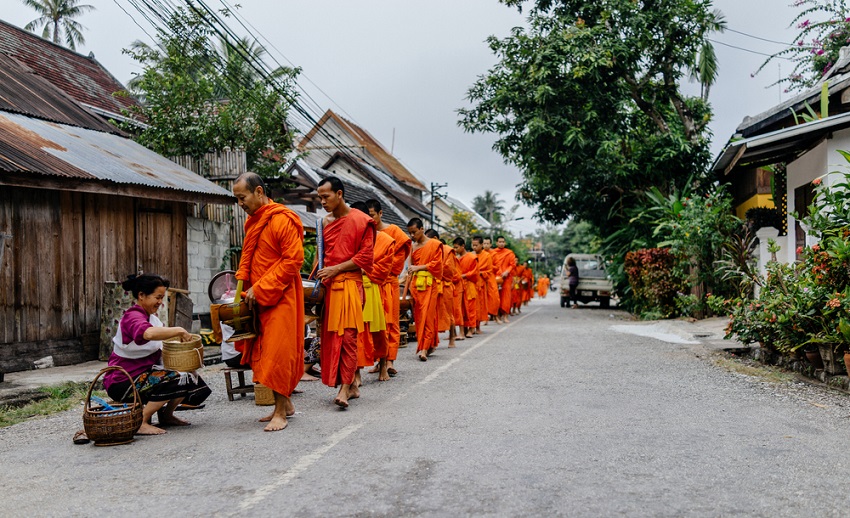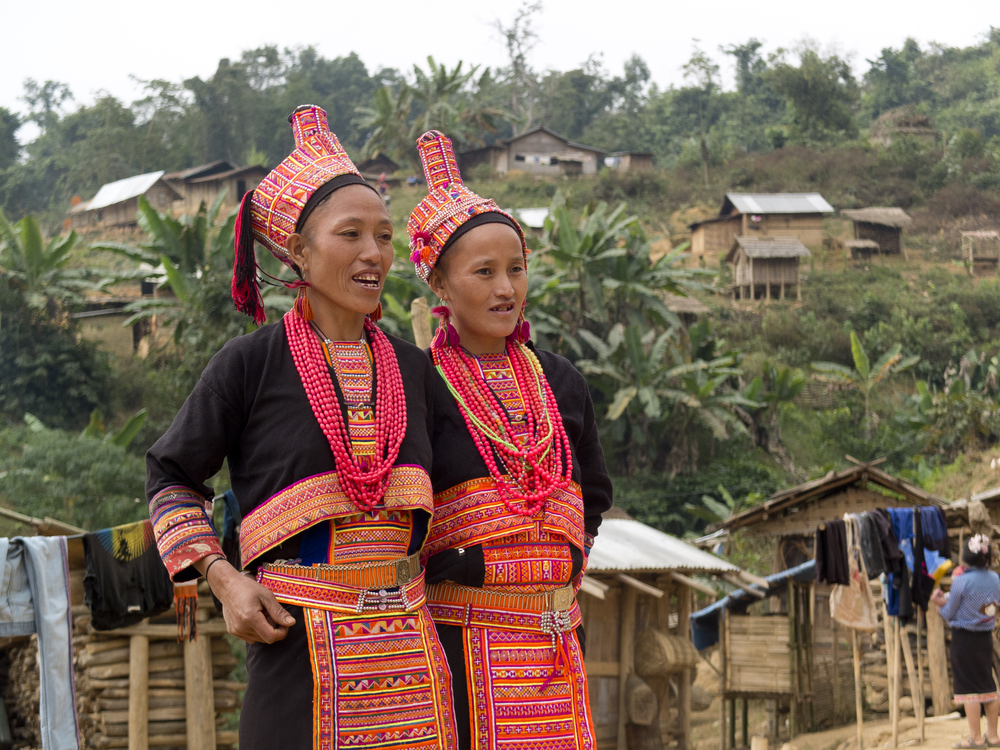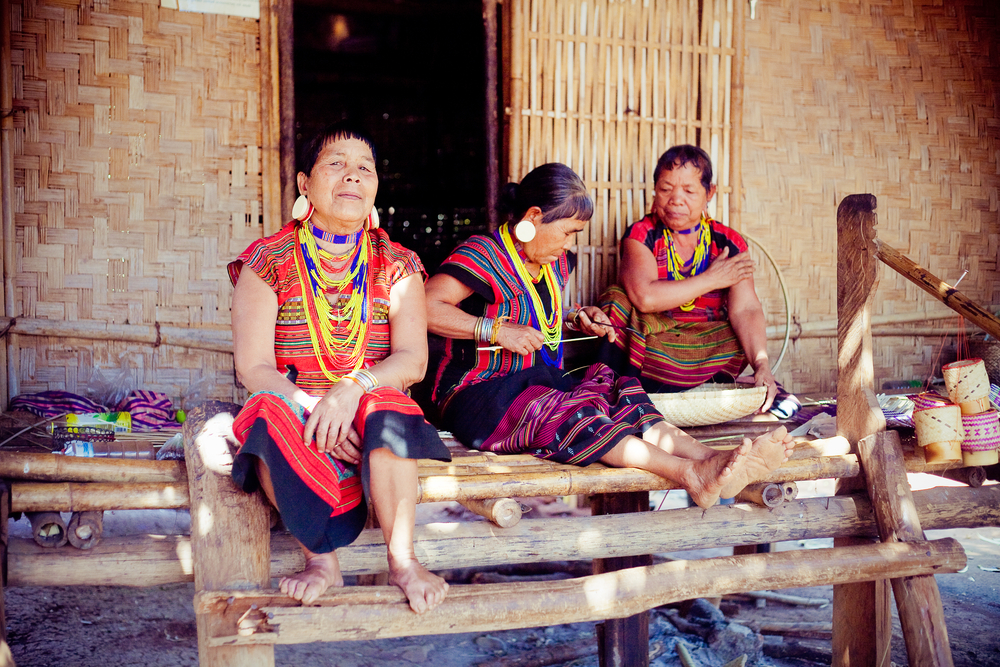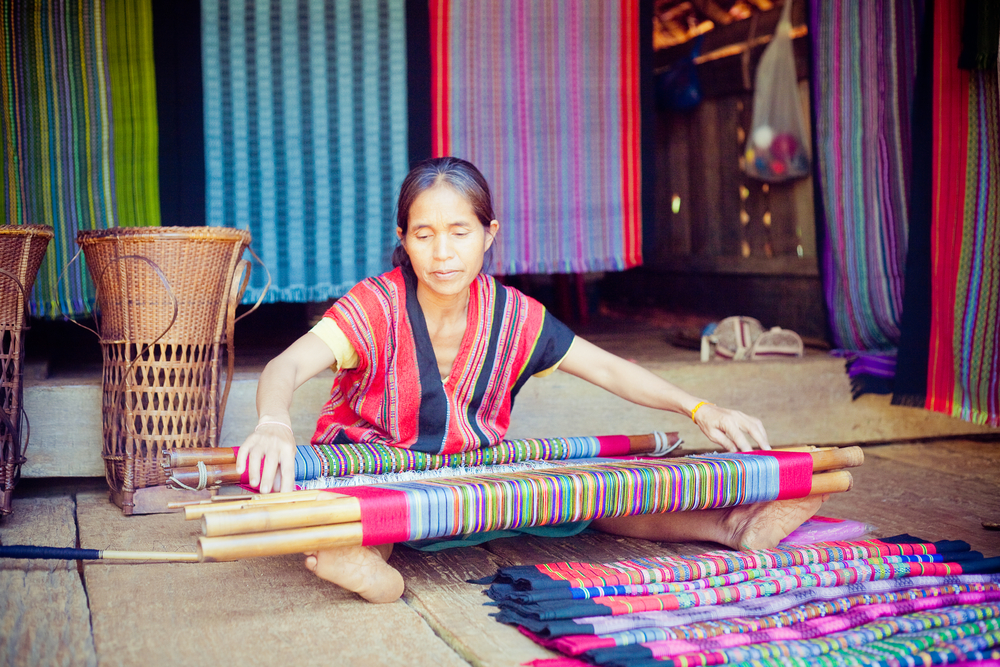Laos - belief and religion
Dr.Taweewat Puntarikwiwat stated that religious beliefs of people living in Southeast Asia had been originally ‘primitive religion’ having a characteristic of Animism. In the past, Southeast Asian people had a belief in the holy ghost and spirit such as household deity, Rukketwda or holy spirits possessing old-aged big trees and tree nymph. (ทวีวัฒน์ ปุณฑริกวิวัฒน์,2553, น.284) Indigenous tribes in Laos, likewise, shared the belief in holy ghost and spirit such as father ghost, mother ghost, grandparent ghost. These entities were later transformed into household deities, town ghosts and demi-angels. However, the belief in holy ghost and spirit in Laos was extending beyond primitive religion and became Brahman and Buddhist beliefs in ghost and holy spirit. (ทรงคุณ จันทจร, 2551, น.15) Therefore, religious beliefs in Southeast Asia including Laos are a mixture of beliefs blending primitive religion with Brahmanism and Buddhism.
The belief systems shared in Southeast Asia including in Laos were explicitly conveyed in a collection of mythology and folklore. A recurrence of Naga tale, for instance, is evident. It is a belief that Naga was the creator of nature, wealth and security. Naga tale has been recurring across Southeast Asia, especially both sides of Mekong River. A myth of Urangadhatu tells a story of Lane Xang Kingdom establishment, which was the ancient kingdom of Laos. Professor Srisak Wallipodom gave an interview on Silapa Mag saying that analyzing symbols in all the collection of mythology and folklore would find at least three characteristics: the symbols belonging to the indigenous groups, the symbols representing earth god and water god and the symbols signifying religious beliefs. (อ้างถึงใน สุจิตต์ วงษ์เทศ, 2554, น.14) Naga is, thus, the representative of the indigenous people whose mutual belief adhered to geography, belief and sociocultural factors in a way in which a crowd of people were engaged in nature-worshipping rituals as they were heavily relied on nature in living their own lives.
The Urangadhatu Book is an ancient valuable evidence telling a story of Naga dating back to primitive time. The tale narrates a group of people moving from Nong Sae located in South of Yunnan of China to Ou River in Laos where they resettled and expanded across many areas by Mekong River. Moreover, the Urangadhatu Book also feeds a myth of Vientiane establishment repeating on ‘the river that runs through a city of Phraya Chanthaburi’. It gives a geographic detail of Vientiane in the time of ancient kingdom where Mekong River ran through the ancient town. The book also mentions to a man named Burichan (ouylouy) who traditionally kept a practice of merit making as always. One day Naga happened to see the good deeds he had done, so Naga worked his magic to transform the man to be even more good looking and wealthier. In addition to a better life, Naga founded a town called Chanburi for him to rule. (สุจิตต์ วงษ์เทศ, 2554, น.127-128) Apart from establishing towns for human to rule, Naga helps protect the towns as conveyed in a tale of Khun Borom Raja. Naga of 15 families were protecting both sides of Mekong River, so the towns established on both sides enjoyed wealth, security and abundant natural resources. Each Naga was taking up a post at natural places like cave, water source and mountain. (สุจิตต์ วงษ์เทศ, 2554, น.196)
A myth of tribal origins shared in Southeast Asia is almost identical albeit different in details. Most plots believe this universe is divided into two levels. The heavenly level is a residence of the god Taen while the Loum or lower level is the earth where humans occupy. A Lao belief that tribes on earth shares the same origin in which they were born out of a bottle gourd (ปรานี วงษ์เทศ, 2543, น.289) is recurred in Lane Xang annals, Lao folklore and a written record appeared on a subtitle of Khun Borom Raja. Tao Hung Cheung, likewise, a popular epic among people of both sides of Mekong River, bears trace of this shared belief. Thai-Lao literature praising the heroes of both sides of Mekong River after which the towns had been founded and begun forming capital cities reflects bonded relationships between people in Southeast Asia. The attempts to unify the tribes to implement a unity of societies, politics and cultures had been achieved before religious invasion.
Buddhism in Laos
Buddhism is one of shared culture in Southeast Asia especially Theravada Buddhist countries like Laos, Thailand, Myanmar and Cambodia. For Laos, Buddhism is a foundation of belief, value, culture and way of life. It has, thus played a vital role in shaping Laos. Buddhist developments in Laos concerning social and political contexts can be looked into 3 periods of time.
Buddhism in Kingdom Era
Buddhism in ancient kingdoms such as Lane Xang Kingdom, Kingdom of Vientiane, Kingdom of Luang Phrabang and Kingdom of Champasakwas wholeheartedly embraced by both the people and the monarchies in a way that the monarchs were obliged to a duty of supporting Buddhism. In fact, Lao Buddhism was very much influenced by Buddhism in nearby kingdoms or the now-neighboring countries. Mon-influenced Theravada Buddhism had been introduced to Laos first before the the ruler, Fa Ngum, adopted Cambodian Theravada Buddhism. It has been a mainstream religion since then. Meanwhile, Dhammayut-Theravada Buddhism came into knowledge at a time when Laos was under Thai rule. Buddhism in ancient times was well-established. Fighting wars contributed so little to the religion because it was wars with Buddhist neighboring countries. Religious exchanges regularly occurred.
The contacts between groups of monks from Lan Xang, Lanna and Thailand had stayed very closely when Pali-Sanskrit Studies and Literature flourished. Formal letters by Supreme Patriarch of Vientiane once exchanging with ones from Supreme Patriarch of Thonburi were written in Pali-Sanskrit. All was so difficult nobody could read it even those who had studied Pali-Sanskrit. (พระมหาดาวสยาม วชิรปัญโญ, 2555, น.98)
Moreover, a relationship between the people and Buddhism during early Lane Xang was remarkable. The people embraced Buddhism. Temples and monks were majorly involved in many aspects of life. The temples became the heart of the society in a way in which the monks did not only teach and advocate to Buddha teachings, but also provided some advices for the people. The monks, therefore, took a role of both spiritual and intellectual leaders. The temples function as a service center of the society serving both religious and secular purposes such as schools, arts and culture centers, clinics, foster homes and meeting points for the people. (ทรงคุณ จันทจร, 2551, น.25-26)
Buddhism under French Rule and in a time of Independence
When colonialism took over Asia, Laos inevitably fell at the hands of France whose views on Laos were nothing but the underdeveloped. Believing they were superior and more civilized, France allowed Roman Catholicism and groups of missionaries into Laos to covert the people as well as forcing French on spoken language. It profoundly affected Laotian ways of life regarding language, culture and Buddhism. Buddha teachings including Buddhist doctrines were banned, meanwhile some parts of abandoned archeological sites were taken away and used to rebuild houses, hotels and tea shops. Schools and temples were deliberately separated. However, the Laotians and the monks did not give up by putting up countless forms of non-violent fights including founding Chanthaburi Council for Monk Educational Improvement and Intellectual Club of Lao Language and Culture Development. As a result, it has enabled Lao people to conserve and continue their original Lao written characters until now.
After Laos had achieved independence from France, Buddhism was rising again. The Buddhist monk-ranking entitlement, higher institutions of Buddhist Studies, Buddhist moral-based schools for Lao youth, Buddhist associations and Revision of Tripitaka are what has been seen flourished.
Buddhism after a change of regime
After the fall of a constitutional monarchy regime, communism ruling over Laos caused tremendous changes radically affecting Buddhism. In adopting Marxist ideology, the Socialist Laos took absolute controls over Buddhism and the monk establishment by trying to put Buddhism and its sanctity away from the scene as evident in following examples.
- Supreme Patriarch and the monk ranking entitlement were abolished. Despite fostering Monk schools, Pali-Sanskrit Studies was replaced by Socialist Studies.
- Monk meditation was never made easy as the monks were required to increase productions by working at pig or chicken farms and growing vegetables. If one did not conform, he would be killed. On the contrary, the monks working as political instruments in remote areas were praised.
- Entering monkhood was strictly forbidden, so the number of monks was in decline. Furthermore, some laymen advertised for job vacancies luring the monks to quit their monkhood.
- The monks were segregated from the people. Anonymous letters were handed out to the temples with an attempt to stain the monks so that the people would no longer respect them.
To make the matter worse, Buddhism was used as a political tool to legitimize the socialist regime in order that the people would accept a new perspective on Buddhism and Marxism. The strategy employed was to redefine monk establishments as one body of a religious sect under The Lao Buddhist Fellowship Organization placed under Lao People’s Revolutionary Party. The monks in Laos were strictly monitored by the state mechanism. In addition, political seminars for monks were held to impose communist ideology training the monks to become a key communicative tool between the communist party and the people. (สมบูรณ์ สุขสาราญ, 2534, น.107) During 1975-1980, Buddhism was exploited as a communist propaganda constitution. The Buddha teachings the monks had explained or interpreted needed to conform to Marxist communism such as the Three Marks of Existence and dialectical Marxism.
However, policies and operations towards Buddhism and the monk later were made more loosened and compromising. After 1980, Lao monks were granted freedom to preach as the people could hold Buddhist rituals. An interview of Dr. Somboon Suksamran in 1989 stated that
“At first the government persisted in distorting what appeared to be Buddha teachings as being unable to ignore or overlook the fact that there had been a belief in superstitious including Buddhist traditions and ceremonies that most people were clinging to. The state insisted Laos could have a uniform of Buddhism. That is two sets of ideas combining Buddhism and Marxism-Leninism. But later the government realized traditional Buddhism had been deep-rooted in the heart of the people for so long that the monks became part of life. The people wholeheartedly embraced them. Offending Buddhism and the monks was deemed a rebellious act waging a war between the people, the government and the communist party.” (สมบูรณ์ สุขสาราญ, 2534, น.108)
The interviewed pointed that eventually Marxism had managed to compromise with Buddhism in Laos for that both could coexist in Lao society. Marxism employed the monk establishments to legitimize the new ideology while the Lao society could not live without the roots of culture like Buddhism.
“Yet Buddhism has proved more durable than the Party. It has survived because it is central to the cultural identity of Laos, and because most lowland Lao have remained Buddhists at heart.” (Stuart-Fox, Martin, 2002, P.152)
Martin Stuart-Fox, an Australian scholar expertized in Lao Studies, noted in ‘Buddhist Kingdom, Marxist State: The making of modern Laos’ inferring stamina of Buddhist presence in Laos. It is resilient enough to survive political turbulence because Buddhism has been the heart of Lao culture, the roots and identity of what appeared to be Laos. It is, thereby, plausible for the Lao people to inseparably hold on to Buddhism no matter what era they have been through.
Morals and values in Lao society stem from Buddhism since it has been a key establishment assigning social orders in a way that Theravada Buddhism in Laos brings the people into conformity with Buddhist tradition regarding ways of life and embracing Buddha teachings. Moreover, it is as if it was even more than a law making Buddhists bound to social restrictions. The temples and monks are a key mechanism accessible to people’s ways of life and have great effects on overall society. Marxism, thus, sees the opportunity to exercise its power through the Buddhist establishment which functions as a medium of communication between the state and the people. What seems distinguished with Buddhism in Laos is the fact that it can blend with Marxism while the regime exploits Buddhism for its legitimacy in setting policies, creating propagandas, building a new society and redefining values to control, rule and create a national unity. However, the regime that emphasizes on restriction, regulation and sufficient ideology has contributed so much to the stamina of Buddhism in Lao. It is more purified than any other countries in this region due to Lao excommunicated society. Now the government allows freedom the monk establishment as monk institutions and original monk schools are being revived.
Bibliography
ทวีวัฒน์ ปุณฑริกวิวัฒน์. (2553). พุทธศาสนากับสังคมการเมืองในอุษาคเนย์. ใน สุเจน กรรพฤทธิ์ และ สิทธา เลิศไพบูลย์ศิริ (บรรณาธิการ). อุษาคเนย์ที่รัก. กรุงเทพฯ. (หนังสือที่ระลึก ฉลองครบรอบ 10 ปี โครงการเอเชียตะวันออกเฉียงใต้ศึกษา คณะศิลปศาสตร์ มหาวิทยาลัยธรรมศาสตร์).
ทรงคุณ จันทจร. (2551). แขวงหลวงพระบาง สาธารณรัฐประชาธิปไตยประชาชนลาว: เศรษฐกิจ สังคม วัฒนธรรม.มหาสารคาม: สถาบันวิจัยศิลปะและวัฒนธรรมอีสาน มหาวิทยาลัยมหาสารคาม.
ปรานี วงษ์เทศ. (2543). สังคมและวัฒนธรรมในอุษาคเนย์. กรุงเทพฯ: ศิลปวัฒนธรรม.
พระมหาดาวสยาม วชิรปัญโญ. (2555). พระพุทธศาสนาในลาว (พิมพ์ครั้งที่ 2). พระนครศรีอยุธยา: สถาบันวิจัยพุทธศาสตร์ มหาวิทยาลัยมหาจุฬาลงกรณราชวิทยาลัย.
สมบูรณ์ สุขสำราญ. (2534). รายงานผลการวิจัยเรื่อง พุทธศาสนากับความชอบธรรมทางการเมือง กรณีเปรียบเทียบประเทศไทย ลาว และกัมพูชา. กรุงเทพฯ: โครงการเผยแพร่ผลงานวิจัย ฝ่ายวิจัย จุฬาฯ.
สุจิตต์ วงษ์เทศ. (2554). นาค มาจากไหน? (พิมพ์ครั้งที่ 3). กรุงเทพฯ: โพสต์บุ๊กส์.
Stuart-Fox, Martin. (2002). Buddhist Kingdom, Marxist State: the making of modern Laos (2nd Edition). Bangkok: White Lotus.





